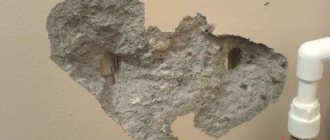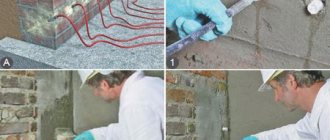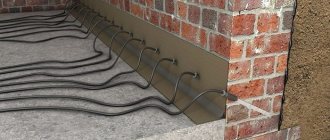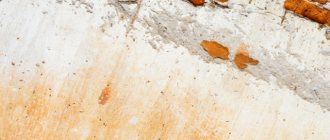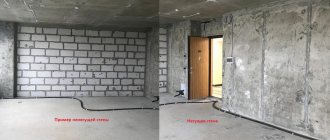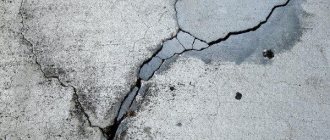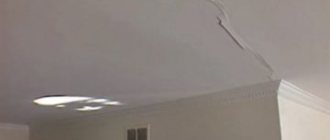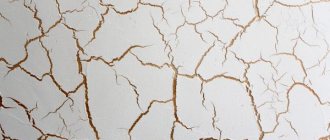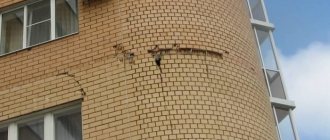Brick is a popular building material. Due to poor-quality manufacturing technology, the product often deforms, after which it cracks. This has a negative impact on the finished structure and requires sealing of cracks in the brick walls. But first, the master finds out the reason for this condition, and then decides how to repair the crack in the brick wall of the house. Not only low-quality material, but other factors can become a provocateur of the process.
Why do they arise?
The main triggers for the development of cracks inside bricks include:
- Pouring the foundation to an insufficient depth (it is less than the level at which the soil freezes), using concrete that has poor strength and is unstable to winter temperature changes. In such a situation, cracks appear in the corners of the building or cuts in the facing bricks at the top of the wall quickly increase.
- Incorrect assessment of soil quality, which caused errors when taking into account the load. The problem is manifested by large cracks along the entire perimeter in the load-bearing wall.
- The causes of vertical cracks in brickwork are poor connection of elements or its complete absence.
- Shrinkage of the structure in the first year of operation. This condition is expressed by small narrow cracks that do not change further.
- Heavy load on the masonry. Breaks are observed at points of greatest stress.
When deciding how to eliminate damage, you must first correctly determine the root cause of the destruction.
Jointing technology during construction
In this case, the seams are processed immediately after laying several brick lines. The starting point for work is the beginning of hardening of the composition. The composition itself must retain its plasticity.
It is important to follow the following sequence:
- When laying this material, the entire composition that protrudes outwards is cut off flush with the laid masonry. Such pruning significantly increases the rate of jointing. An example of this is shown in the figure below:
Pruning
- The wall surface is thoroughly cleaned. The working tool is a stiff fleecy brush.
- Sewing vertical seams. The tool moves from top to bottom and is pressed into the masonry. Air is removed from the composition by pressure. The density and strength of the composition develops. First of all, short seams are unstitched vertically.
- To make the seams horizontally even, a wooden strip is attached to their underside. You should lean on it and guide it along the masonry line. Uniform pressure here will create a pleasant aesthetic finish.
- Filling seams vertically. Then - horizontally. Movement on the working surface: from top to bottom.
- When the composition has completely set, the elements of the jointing mixture are removed from the wall. A broom or brush is used here.
What are they?
Construction work (digging a pit next to a structure, driving piles, laying foundations in the neighborhood), and frequent temperature changes can also provoke the formation of cracks on the facade. Based on the type of deformation that occurs, cracks are classified into the following types:
- inclined or curved;
- closed or through.
The following types of cracks are found in size:
- minor - up to 5 mm;
- average sizes - 5–10 mm;
- wide gaps - over 20 mm.
It is the latter option that refers to dangerous situations, so you need to know how to correctly stop a destructive reaction. In the process of restoration work, it becomes necessary to carry out additional measures to strengthen the gap and the entire wall. If with a medium or small crack the problem can be solved simply, then it is impossible to repair wide splits without eliminating the root cause of their occurrence.
To obtain a positive result, knowledge of how to repair a crack in a wall on a brick house and experience possessed by qualified craftsmen are required.
Why do they do it?
Experts call the procedure for processing the seams of brickwork jointing. The grouting process is the application of an additional layer to cement joints. Performed if the walls are not planned to be subjected to additional cladding work. The jointing has a decorative function and also has practical characteristics.
Decorative properties are as follows:
- highlighting the texture of lines and brick patterns;
- combining vertical and horizontal lines;
- strict and clear appearance of the facade.
Practical properties include:
- increasing the level of sound insulation;
- protection from excessive moisture;
- improved heat retention;
- increased service life of the building;
- tightness.
Brick joint grout seals all cracks and covers the cement layer.
This procedure is not able to eliminate errors in the form of uneven masonry, excess cement, curvature, or stains on the wall.
Some buildings are operated without jointing, so it is necessary to note the main purpose of this procedure. As mentioned above, in this way it will be possible to increase the aesthetic perception at the first glance at the building. By resorting to this method of decoration, you can mask differences in color that may arise if the solution was mixed gradually.
Grouting for external use helps prevent the destruction of the cement mixture, thus extending the life of the building and postponing the need for major repairs for a long time. This result can be achieved by protecting the joints from excess moisture, which has a destructive effect on the cement mortar.
Elimination Tips
In brick walls, repairs should be carried out only after the condition has stabilized. Then there will be confidence that the fault will stop growing. Otherwise, you will only be wasting money on the materials used. The diagnostic stages are as follows:
- Apply a strip of cement or gypsum composition to the split area and observe the behavior of the defect for about a month. In the absence of further destructive process, cracks in brick walls can be sealed with cement mortar.
- Fixing plate beacons on the surface of bricks helps determine the problem. This event will establish the dynamics of the gap.
- Also, for diagnostic purposes, you can use a strip of paper secured with silicate glue. If it is unharmed, you can begin restoring the masonry.
The last option is acceptable only for dry rooms; it is not advisable to carry it out outdoors. For small cracks, the optimal size of the strips used is 10x4 cm. Before installing the beacons, first ensure that dirt, plaster, and dust are removed.
The technology for sealing cracks in brick walls depends on the location and size of the gap. If the problem is indoors, you can eliminate it with gypsum putty. Moisture-resistant materials are recommended on the outside of the building or in rooms with high humidity.
What to do if the wall is cracked? First of all, prepare mixtures and special equipment.
Possible options
There are several options for how to do the jointing. The visual effect that the wall will receive depends on the chosen method.
When working on the filling, you need to follow the sequence, starting first with the vertical seams, and then with the horizontal ones.
Special attention is not paid to the thickness of the seams. The indicator can vary from ten to fifteen millimeters for horizontal seams, and from eight to twelve for vertical ones. But most often you can find thin seams, four millimeters thick. This decision was driven by the desire to save on cement mixture. Also, the thickness of the seams depends on the worker’s approach to performing the procedure and climatic influence.
The process of finishing the seams is important regardless of the thickness, because a clear pattern will not only decorate the walls, but also increase the performance characteristics of the building. What methods exist to highlight brick seams?
Flush
This option is the easiest to implement. You can do jointing in this way even without a special tool. Filling mortar that protrudes beyond the brick or gets on it is removed with a trowel. After the main process, the seam is processed using a stiff brush.
We recommend: How to choose foamed polystyrene?
Concave
This method requires a special narrow spatula. This small tool will fill the seams. For ease of working on all lines, the spatula should not be long. The cement mortar is removed from the masonry, as in the previous version, after which they go along the seam with a jointing tool. The grout solution is applied inside in the same way.
Convex
To work on jointing with a convex effect, you need an arched spatula. The tool is applied to the seam with the arc part facing outwards, the resulting space must be filled with mortar. Afterwards, the spatula is moved further to the untreated area and the construction mixture continues to be applied.
Undercut or flush
This method is considered the most accessible and is most often used for making masonry joints.
The main idea is that the mortar protruding from the masonry is trimmed with a trowel, after which the seam areas are additionally treated with a hard-bristled brush. Using this method, the joining areas are given ideal smoothness and aesthetics.
Rectangular
This option is more difficult to work with than the previous ones. First, you need to remove five millimeters of cement from the seam, even if it has already dried. After this, the gaps are filled with grout mixture. This design looks interesting, but experts do not recommend using this method for facade decoration due to poor drainage.
Beveled
This method is suitable for buildings that are being built in harsh climates. In this option, the mortar between the seams is not cut straight, but at an angle. The cutting angle should be sharp, 3-5 millimeters.
Required Tools
During the work, the following items and materials are needed:
- putty knife;
- spatula for thoroughly mixing the solution;
- rolled metal;
- container for preparing construction mixture;
- dowels;
- Master OK;
- anchor bolts;
- metal brush;
- scarpel and hammer;
- cement with sand;
- polyurethane foam.
Advantages and disadvantages
Jointing masonry joints has the following advantages:
- this finishing option requires almost no additional building materials;
- the service life of brick walls increases;
- the need for cosmetic repairs is reduced;
- protection of the surface from natural factors is created;
- the work is carried out independently, the involvement of professional specialists is not required;
- the aesthetic appeal of the walls improves;
- masonry mixture is saved.
Unfortunately, there are also certain negative aspects:
- with some jointing methods there is a slight decrease in the thermal insulation properties of the walls;
- walls made of silicate stone require special attention when jointing - it is difficult to remove cement stains from the surface of the facing material;
- the work is painstaking. The slightest mistake spoils the entire appearance of the surface.
Caulking compounds
An available material for eliminating cracking is a sealing mortar based on a cement-sand mixture. Proportions of the basic composition: 3 volumes of sand to 1 part of cement. To eliminate large through splits, you will need to add crushed stone. To improve adhesion, add liquid soap in the amount of 1 tbsp to a bucket of the composition. l., PVA glue - 100 g, purchased ready-made plasticizers. You also need to buy silicone sealant for small cracks; polyurethane foam is suitable for gas and foam concrete.
Regardless of the type of solution, work on its application is permitted only after clearing, caulking cracks, tightening them with metal, removing contaminants and priming. After completing work on the inside, it is necessary to monitor the condition of the walls for at least 2 months.
Types of jointing and their main characteristics
In fact, there are several types of seam stitching. Previously, only two options were considered: concave and convex. In practice, you can find many more of them. These are:
- To the pruning.
- Pustoshovka.
- Simply connected and doubly connected concave.
- Doubly connected convex.
The most popular options are worth considering:
1. Flush - the most common type of jointing. The procedure consists of the following steps: the remaining mortar is cut off from the surface of the wall using a construction trowel, then the gaps between the bricks are processed with a brush, resulting in smooth and clear white seams.
2. Recessed rectangular - this type is used when creating decorative finishes. This variety requires significant labor costs and is more suitable for treating walls indoors, since such jointing cannot withstand constant exposure to precipitation and atmospheric phenomena. The processing technology is as follows: in the seams at a depth of 5 mm, you need to remove the mortar, then compact the new mixture, smooth it using construction tool.
3. Concave – another common option, which involves the use of a special “jointing” tool. Excess mortar is cut off, the seams are processed with semicircular jointing.
4. Beveled - grout is able to withstand harsh climatic conditions, therefore it is common in the relevant regions. To process joints you need to use a carefully sharpened trowel. Grouting is carried out using the following technology: excess mortar is cut off with this tool, located at an acute angle, with a recess of 3-4 mm.
Elimination of narrow gaps
In addition to cement mortar, if cracks appear in the wall of a brick house, you will need a tool that is convenient to clean the gap, enlarge it somewhat (scarpel), as well as reinforcing tape and a regular hammer. To figure out how to repair a crack from the outside, you need to know exactly the sequence of actions:
- complete cleaning of dirt and any previous surface finishing inside and along the crack;
- moistening this area to ensure high-quality adhesion with putty;
- preparation and application of gypsum or cement mortar;
- laying reinforced tape inside the crack, and then surface cementing it.
If there is a microscopic web, there is an easier way to seal the gap. Apply epoxy resin. The prepared composition needs to be filled as deeply as possible into the damaged masonry.
Fixation methods
This applies to cases where large vertical cracks of large sizes, more than a centimeter, appear on the masonry. Cement alone is not enough; a strong metal screed is needed. Fixation and repair options:
- Special anchors. The method involves driving anchors into metal dowels, which must be installed in advance along the edges of each crack.
- Longitudinal metal brackets are mounted and bent at the edges. Before the process itself, you need to create several holes in each wall (When the work is finished, all the holes will be filled with cement mortar). The method is reliable, it is possible to fix even through cracks in thick walls.
Fixation method - You can strengthen the masonry with special elements. This is done from the inside; for this you need to install several fasteners on the surface itself. Next, they are inserted to a sufficient depth, usually at least half of the wall itself. Each fastener can be alternated.
- Reinforcing mesh is an option for rationally strengthening brickwork of any size. It is possible to strengthen not only a certain part of the wall, but the entire surface. The option with reinforcing mesh is suitable for deep crevices and cracks.
Reinforcement mesh
How to remove wide gaps?
When a large crack appears in a brick wall, serious repairs are required; the job will not be completed with plaster alone. Drastic emergency measures will be needed:
- The bricks should be disassembled from above the crack to remove all damaged elements. Replace them with new ones, laying them with a lock, carefully fixing each brick with metal elements.
- If the masonry is torn, it is necessary to use strips, carefully bending their ends between the bricks and squeezing them with anchors, bolts or screws.
If it is not possible to use such methods, you need to fill the crack with crushed stone mixed with cement, and then drive anchors along the sides of the crack, tying them with metal strips.
When a deep gap cannot be completely sealed with cement, it must be filled by injecting a solution. Drill holes around the entire perimeter of the crack (diameter - 30 mm, pitch - 20 cm). Place a tube filled with solution inside each hole. Next, use a pump to pump such a sealant so that it fills all the voids.
Benefits of grouting
- Improving the appearance of the building facade. The grout has a rich color palette. Using contrasting colors, you can emphasize the harmony of the masonry.
- Protection from moisture not only the seams, but also the walls of the house, which increases their service life.
- The sound and heat insulation properties of floors are significantly increased.
It is not always possible to see buildings with similar decoration. If the masonry is subsequently to be plastered or faced, grouting is not required. Advice. When subsequently decorating the seams for masonry, you must use only intact and flawless material, and the seams must be the same in thickness. There are craftsmen who make horizontal seams somewhat thicker than vertical ones. This is a design decision.
If the crack is through
In an effort to eliminate the defect in a situation with a through crack, strengthen the damaged wall:
- first clean the crack area from dirt, dust particles, and any old coating;
- moisten the gap with water, wait until the moisture dries;
- fill the crack with crushed stone and cement mortar;
- fix the gap with steel plates, nailing them with dowels;
- carry out finishing work to hide the damage.
To prevent the crack from opening, drive steel staples into the sides of the crack and then secure them with bolts. Be sure to fill each hole made with cement before fixing it.
Crack in a brick wall: “diagnosis” of the problem and solutions
Cracks that appear on the walls are perhaps the most obvious indicator of the developer’s miscalculations. In this case, the seriousness of the situation is obvious even to those who are far from construction. What are the reasons for the deformation of brick walls and what should the home owner do in this case?
Let's start with the fact that not every gap in the covering of brick walls is a threat to their strength and load-bearing capacity. Immediately after construction, the house “shrinks”: this is a normal process that can lead to the appearance of minor (1-3 mm) cracks.
We are talking about surface cracks that do not increase over time. In this case, you need to wait until the house shrinks and carry out cosmetic repairs. Much more dangerous are through cracks that are visible from the outside of the building.
In such a situation, urgent measures are needed. To decide on a repair technology, you must first understand the reason for the appearance of gaps in the wall. They can be divided into five groups:
Strengthening walls
You should definitely know how to strengthen the wall of a brick house if cracks appear. The most reliable option is strengthening from the inside, which every experienced craftsman will confirm. When, after the repairs have been completed, positive changes have not been achieved, you will have to partially reposition the bricks in the wall.
The method for strengthening the wall from the inside is as follows:
- seal cracks;
- put metal profiles or locks on them, blocking the gap across;
- secure the structure with anchors, thanks to which the crack will stop the expansion process;
- Reliable strengthening is also facilitated by metal brackets, the ends of which need to be slightly deeper into the wall so that they enter half its thickness;
- the repaired wall can be fully used after just 24 hours, although it is recommended to relieve it of heavy loads for a month so that the structure gains full strength.
When cracks are caused by an improperly executed foundation, it also needs to be strengthened. To perform such work, you need to build an auxiliary belt of concrete. The procedure for its arrangement involves digging an additional trench around the perimeter of the building. Its recommended depth is at least a spade bayonet below the old foundation. It is necessary to lay reinforcement inside this trench as an auxiliary belt. To prevent the appearance of new cracks, fill this base, scrupulously following the technology.
The feasibility of using jointing
In construction, grout has decorative and practical significance. The first option has the following properties:
- Emphasize the correctness of the lines.
- A new color is added to the created design.
- The drawing turns out clear and bright.
- The appearance of the structure is improved.
- The masonry is more neat and expressive.
- Grout combines horizontal and vertical lines.
Important! Beginning craftsmen need to remember that processing seams does not eliminate surface defects: excess cement, curvature of walls, fragments of hardened composition on bricks.
High-quality jointing of brickwork
Practical value:
- Protection of cement composition from the destructive effects of moisture.
- Increased sound insulation characteristics.
- Significant extension of the protective properties of the cement base.
- Strengthening the thermal insulation of the building.
- Increasing the strength of brick masonry.
- Strengthening the density of joints.
- Additional tightness.
- Hiding small cracks and crevices.
You can seal the holes if the masonry is done carefully. If there are decorative seams, use whole bricks, without flaws. It is necessary to ensure that the solution has the same thickness on all parts of the surface.
According to accepted SNiP standards, the width of the horizontal and vertical space left should not exceed 15 mm. Grout is used for decorative, building material, gypsum tiles. A special composition is also used for facade panels and natural stone.
Final processing of a brick wall
Application technique
You need to start finishing by preparing the base.
Clean the walls from all dirt and peeling. Fill holes, potholes, sheet joints and other irregularities. Prime the walls with a deep penetration primer.
The basis
The basis for craquelure can be ordinary gypsum plaster or putty, painted in the desired color.
Expert opinion Alexander Guryanov Plasterer and master of decorative finishing The color of the base will appear in the cracked top layer of decorative finishing. The cracks will look natural if they are darker than the base coat. For Venetian plaster, the base can be painted with bronze or gold enamel.
After applying the base, wait until it dries completely (at least 24 hours).
A layer of varnish
Next, a thin layer of craquelure varnish is applied to the base, avoiding smudges. There are three ways:
- brush;
- roller;
- spray gun.
Material consumption - 50 g/m2 per layer.
The varnish is applied in two layers with intermediate drying for at least 1 hour. During this time, the first layer will become transparent.
Dried varnish is difficult to wash off the tool, so after finishing varnishing, rinse your brushes or spray gun thoroughly. The roller attachment can be discarded.
It is better to store leftover varnish in its original packaging. To prevent dirt from getting into it, pour the varnish into a paint tray and dip the tool into it.
Complete drying of craquelure varnish takes 4 hours.
Decorative plaster must be applied no later than a week, otherwise cracks will not appear.
Finish coating
Decorative plaster can be embossed or smooth - Venetian. It is also possible to apply textured paint. Each case has its own methods and techniques of decoration, but there are basic rules for craquelure:
- The thickness of the finish should not be more than 2 - 3 mm when plastering, and 1 mm for water-dispersion paint, otherwise there will be smudges.
- Since the main finishing elements will be cracks, you should not create another pronounced texture. You can leave small layers or shagreen.
- You need to work quickly and join sections “in the wet.” Leveling the plaster and creating the texture should take no more than 10 minutes. If the wall is being painted, then the time between passes is no more than 1 minute, otherwise the paint will pull off behind the tool.
Drying of the finishing coating: decorative plasters - 48 hours, paints - 24 hours. Application of protective varnish is possible only after the finish has completely dried.
Formation of cracks
Expert opinion Alexander Guryanov Plasterer and master of decorative finishing
- The direction of movement of the tool determines which direction the cracks will go.
- The thinner the layer of plaster, the smaller and more uniform the cracking. Torn and sparse craquelure is obtained with a layer of 2 mm.
- Also, the shape of the cracks depends on the thickness of the intermediate varnish layer and the type of plaster (paint). Materials from different manufacturers will give different effects.
- If you apply paint with a spray gun, you will get the most even network of cracks.
The appearance of cracking begins:
On plaster - after 10-15 minutes, completed after 5-6 hours.
On paint - after 5-10 minutes, completed after 1-2 hours.
Support structures
In the event that the brickwork of a house begins to collapse (while losing its verticality), the way out of this situation will be to strengthen the brick walls by erecting a supporting structure. One supporting wall or several are built perpendicular to the masonry, depending on the specific situation.
The supporting structure can have different shapes (triangle or trapezoid). As for the base of the additional reinforcing structure, it must correspond to the parameters of the main foundation. In this case, the bases themselves should be tied together with anchors.
Methods for strengthening brickwork
This event is carried out to increase the strength of the structure. And if you take a responsible approach to the technology of strengthening brick walls, you can restore a surface whose strength loss is up to 50%. And to ensure that destruction does not occur at all, it is necessary to comply with all norms and rules even at the stage of construction of the facility.
At the same time, increased attention is paid to the supporting elements of structures, because if they lose their load-bearing capacity, the house will inevitably begin to collapse. However, if signs of destruction are already visible, then appropriate measures should be taken immediately.
If the problem concerns the wall itself, then there are different ways to strengthen it. Among them, the most common technique is the injection procedure using special clips and composite materials. Let's consider how, in fact, external walls can be strengthened, in more detail. But first, let's touch on the issue of foundation repair.
What not to do?
During the process of repairing cracks in brick walls, errors may appear :
- Failure to eliminate the main reason that caused the defects. If the cause is problems with the foundation or loads, then surface repairs will only give a short-term effect.
- Uneven masonry during deep wall repairs and poor binding of bricks. Deviation in level (vertical or horizontal) can form a bulge that cannot be eliminated with plaster. Vertical seams should not coincide with adjacent ones.
- Sealing on an uncleaned surface. Dirt, debris, mortar and brick residues that are not removed before starting restoration work can cause poor adhesion to the new mortar or sealant. This will lead to ineffective ongoing repairs.
- Inaccuracy when filling the pores with a solution of concrete or sealant. If the solution has not completely filled the space, then there is a possibility that under the influence of atmospheric air pressure the crack will begin to diverge again.
- Refusal of the screed. In case of serious damage, it is better to tighten the edges of the crack. This will help prevent further destruction of the masonry, and will provide a good stable base for filling the pores of the wall.
Failure to comply with the temperature conditions when performing repair work can also be considered a mistake. Normally, it is believed that the entire process with a brick wall should be carried out at a temperature above + 5°C.
